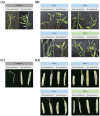Function Analysis of the PR55/ B Gene Related to Self-Incompatibility in Chinese Cabbage Using CRISPR/Cas9
- PMID: 35563453
- PMCID: PMC9102814
- DOI: 10.3390/ijms23095062
Function Analysis of the PR55/ B Gene Related to Self-Incompatibility in Chinese Cabbage Using CRISPR/Cas9
Abstract
Chinese cabbage, a major crop in Korea, shows self-incompatibility (SI). SI is controlled by the type 2A serine/threonine protein phosphatases (PP2As). The PP2A gene is controlled by regulatory subunits that comprise a 36 kDa catalyst C subunit, a 65 kDa regulatory A subunit, and a variety of regulatory B subunits (50-70 kDa). Among them, the PP2A 55 kDa B regulatory subunit (PR55/B) gene located in the A05 chromosome has 13 exons spanning 2.9 kb, and two homologous genes, Bra018924 and Bra014296, were found to be present on the A06 and A08 chromosome, respectively. In this study, we performed a functional analysis of the PR55/B gene using clustered regularly interspaced short palindromic repeats/CRISPR-associated system 9 (CRISPR/Cas9)-mediated gene mutagenesis. CRISPR/Cas9 technology can be used to easily introduce mutations in the target gene. Tentative gene-edited lines were generated by the Agrobacterium-mediated transfer and were selected by PCR and Southern hybridization analysis. Furthermore, pods were confirmed to be formed in flower pollination (FP) as well as bud pollination (BP) in some gene-edited lines. Seed fertility of gene-edited lines indicated that the PR55/B gene plays a key role in SI. Finally, self-compatible T-DNA-free T2 gene-edited plants and edited sequences of target genes were secured. The self-compatible Chinese cabbage developed in this study is expected to contribute to Chinese cabbage breeding.
Keywords: Brassica rapa; CRISPR/Cas9; PR55/B gene; self-incompatibility.
Conflict of interest statement
The authors declare no conflict of interest.
Figures







Similar articles
-
CRISPR/Cas9-Mediated Editing of AGAMOUS-like Genes Results in a Late-Bolting Phenotype in Chinese Cabbage (Brassica rapa ssp. pekinensis).Int J Mol Sci. 2022 Nov 30;23(23):15009. doi: 10.3390/ijms232315009. Int J Mol Sci. 2022. PMID: 36499334 Free PMC article.
-
CRISPR/Cas9-Mediated Mutagenesis of BrLEAFY Delays the Bolting Time in Chinese Cabbage (Brassica rapa L. ssp. pekinensis).Int J Mol Sci. 2022 Dec 29;24(1):541. doi: 10.3390/ijms24010541. Int J Mol Sci. 2022. PMID: 36613993 Free PMC article.
-
Identification and Characterization of PSEUDO-RESPONSE REGULATOR (PRR) 1a and 1b Genes by CRISPR/Cas9-Targeted Mutagenesis in Chinese Cabbage (Brassica rapa L.).Int J Mol Sci. 2022 Jun 23;23(13):6963. doi: 10.3390/ijms23136963. Int J Mol Sci. 2022. PMID: 35806003 Free PMC article.
-
Progresses of CRISPR/Cas9 genome editing in forage crops.J Plant Physiol. 2022 Dec;279:153860. doi: 10.1016/j.jplph.2022.153860. Epub 2022 Nov 8. J Plant Physiol. 2022. PMID: 36371870 Review.
-
The CRISPR/Cas9 system and its applications in crop genome editing.Crit Rev Biotechnol. 2019 May;39(3):321-336. doi: 10.1080/07388551.2018.1554621. Epub 2019 Jan 15. Crit Rev Biotechnol. 2019. PMID: 30646772 Review.
Cited by
-
CRISPR/Cas9: efficient and emerging scope for Brassica crop improvement.Planta. 2025 Jun 4;262(1):14. doi: 10.1007/s00425-025-04727-9. Planta. 2025. PMID: 40464976 Review.
-
Gene editing of authentic Brassica rapa flavonol synthase 1 generates dihydroflavonol-accumulating Chinese cabbage.Hortic Res. 2023 Nov 14;10(12):uhad239. doi: 10.1093/hr/uhad239. eCollection 2023 Dec. Hortic Res. 2023. PMID: 38094586 Free PMC article.
-
Gene coexpression analysis reveals key pathways and hub genes related to late-acting self-incompatibility in Camellia oleifera.Front Plant Sci. 2023 Jan 24;13:1065872. doi: 10.3389/fpls.2022.1065872. eCollection 2022. Front Plant Sci. 2023. PMID: 36762174 Free PMC article.
-
Genetic Analysis Based on CRISPR/Cas9 Technology in Plants.Int J Mol Sci. 2023 Nov 16;24(22):16398. doi: 10.3390/ijms242216398. Int J Mol Sci. 2023. PMID: 38003586 Free PMC article.
-
Molecular insights into self-incompatibility systems: From evolution to breeding.Plant Commun. 2024 Feb 12;5(2):100719. doi: 10.1016/j.xplc.2023.100719. Epub 2023 Sep 16. Plant Commun. 2024. PMID: 37718509 Free PMC article. Review.
References
-
- Igic B., Lande R., Kohn J.R. Loss of self-incompatibility and its evolutionary consequences. Int. J. Plant Sci. 2008;169:93–104. doi: 10.1086/523362. - DOI
MeSH terms
Grants and funding
LinkOut - more resources
Full Text Sources

